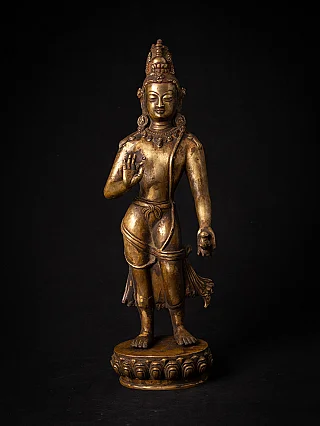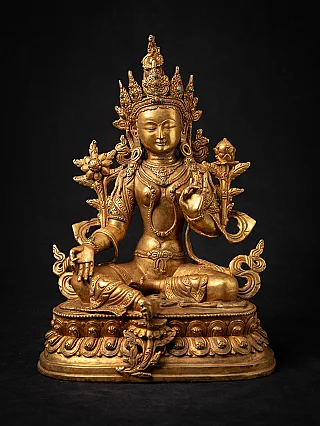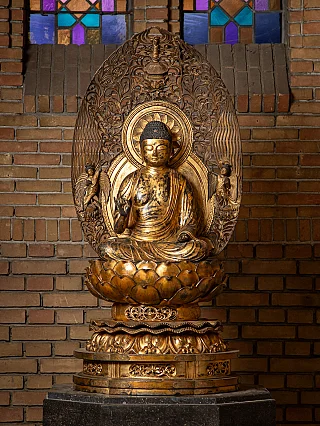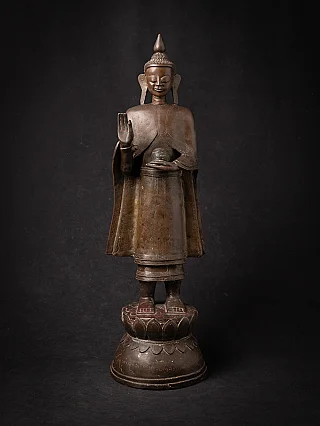Vitarka Mudra

See our Buddhas in Vitarka mudra
In Buddhist iconography's vast and intricate world, Mudras—the symbolic hand gestures—play a crucial role in conveying the profound spiritual messages and teachings of the Buddha and other enlightened beings. Each Mudra embodies specific meanings and teachings, acting as a visual language that communicates the essence of Buddhist philosophy. Among these, the Vitarka Mudra is a gesture of intellectual discourse, education, and transmitting the Buddha's wisdom; a Mudra symbolizes sharing knowledge, engaging in discussion, and conveying spiritual truths.
The Essence of Vitarka Mudra

The Vitarka Mudra is recognized by the thumb and index finger joining together to form a circle while the other three fingers remain extended. This circle represents the continuous flow of energy and wisdom, symbolizing the unending teaching and learning cycle. The gesture is often performed with the hand held at chest or shoulder level, the palm facing outward, signifying openness and the act of communication.
This Mudra is mainly associated with the Buddha's teachings and is often depicted in statues and images of the Buddha as a teacher or a guide. The Vitarka Mudra is a static gesture and a dynamic representation of the intellectual and spiritual engagement central to Buddhist practice. It reflects the importance of dialogue, debate, and the sharing of ideas in spreading the Dharma—the Buddha's teachings.
Symbolic Meaning and Variants of Vitarka Mudra

Vitarka Mudra is rich in symbolism, with each element of the gesture carrying significant meaning. The circle formed by the thumb and index finger is a universal symbol of perfection, unity, and the unbroken flow of wisdom. This circle represents the teaching and learning cycle, emphasizing that knowledge is a continuous process that evolves through discussion and intellectual engagement.
The extended fingers are also symbolic. In many interpretations, the three extended fingers represent the three jewels of Buddhism—the Buddha, the Dharma (teachings), and the Sangha (community). This reinforces the idea that the Mudra is about transmitting knowledge and the interconnection between the teacher, the teachings, and the community of practitioners.
Over time, various versions of the Vitarka Mudra have emerged, reflecting the diversity of Buddhist traditions and cultural influences. In some depictions, the Mudra is shown with both hands, where the left hand is placed on the lap in a meditation posture, and the right hand is raised with the thumb and index finger forming the circle. This dual-hand version symbolizes the balance between meditation (dhyana) and teaching (Dharma), indicating that both are essential to enlightenment.
In East Asian and Tibetan Buddhist traditions, the Vitarka Mudra often features subtle variations. For instance, in some Tibetan representations, the thumb and middle finger touch to form a circle, symbolizing great compassion (karuna) and wisdom. This variation, known as the Prajna Mudra or the Mudra of Great Wisdom, highlights the compassionate nature of the Buddha's teachings. Another variant involves the thumb touching the ring finger, symbolizing good fortune and prosperity. These variations demonstrate the adaptability of the Mudra across different cultures and its capacity to convey multiple layers of meaning.
Historical Significance: The Dvāravatī Period and Beyond
Vitarka Mudra holds a significant place in Buddhist art history, particularly during the Dvravat period in Thailand, which spanned from the 6th to the 11th centuries. The Dvravat kingdom, known for its deep Buddhist roots, produced a wealth of Buddhist art and iconography, much of which featured the Buddha in the Vitarka Mudra. This period is marked by a distinct style that emphasized the Buddha's role as a teacher and a guide, with the Vitarka Mudra symbolizing the Buddha's intellectual discourse and the transmission of his teachings to his disciples.
In the Dvravat period, Buddha statues often depicted the Vitarka Mudra in sitting and standing postures, reflecting the Buddha's role in engaging with his followers in various settings. The Mudra's presence in these statues highlights the kingdom's focus on disseminating Buddhist teachings through intellectual and spiritual discussion. This emphasis on education and dialogue is a key characteristic of the Dvravat period, which saw the flourishing of Buddhist thought and the spread of the Dharma across Southeast Asia.
Beyond the Dvravat period, the Vitarka Mudra continued to play a central role in Buddhist art and iconography, particularly in regions where Mahayana Buddhism was prominent. In East Asia, for instance, the Mudra became a common feature in depictions of the Buddha and Bodhisattvas, such as Manjushri, the Bodhisattva of Wisdom, who is often shown with this gesture. In these contexts, the Vitarka Mudra symbolizes teaching and the refinement and clarification of Buddhist philosophy through intellectual debate and discourse.
In Tibetan Buddhism, the Vitarka Mudra is often associated with esoteric practices and the transmission of secret teachings. It is frequently depicted in Yab-Yum figures, where deities are shown in union, representing the fusion of wisdom and compassion. In this context, the Vitarka Mudra is seen as a gesture that conveys profound spiritual teachings that go beyond conventional understanding, pointing to the deeper truths of the Buddhist path.
Vitarka Mudra in Contemporary Art and Culture

Today, the Vitarka Mudra continues to be a powerful symbol of intellectual inquiry and the transmission of knowledge. It is a gesture that resonates with the universal human pursuit of truth, understanding, and enlightenment. In contemporary Buddhist art, the Mudra is often depicted in statues, paintings, and other forms of visual art, serving as a reminder of the importance of dialogue, debate, and the sharing of wisdom in the quest for spiritual growth.
Moreover, the Vitarka Mudra has transcended its traditional religious context to become a symbol of intellectual and educational endeavors in a broader sense. It is used in various settings to represent the value of discussion, teaching, and the free exchange of ideas. Whether in academic institutions, spiritual communities, or public discourse, the Mudra is a powerful reminder of the role of knowledge in shaping human experience and fostering understanding.
The Vitarka Mudra, with its rich history and profound symbolism, continues to inspire those on the path of spiritual exploration and intellectual engagement. It is a gesture that embodies the essence of Buddhist teachings—compassionate wisdom shared through thoughtful discussion—and serves as a guide for those seeking to deepen their understanding of the Dharma and the world around them.
(Japanese: Seppo-in, An-i-in; Chinese: Anwei Yin)
Share this page
































